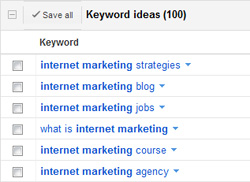Your Marketing Toolbox: Internet Marketing
This series breaks down different marketing tactics to help you determine which ones will best support your marketing strategy.

Today internet marketing plays a central role in how customers learn about your business.
Suppose you wanted to purchase business accounting software. Your search would probably look something like this:
1. Go to a search engine and type “small business accounting software.”
2. Scan the first page of search results.
3. Click on a link that looks promising, and then scan the website for features and pricing.
4. Bookmark it for comparison later, and look at a few more options.
5. Choose a product, buy it online with a credit card and download the software.
And you may have done it all without much consideration – before asking a friend for their opinion or driving to Staples to hear what a salesperson recommends.
Today people jump online for even the smallest purchase decisions, so internet marketing should be a regular part of your marketing activities. It’s probably the most versatile medium out there, allowing businesses to provide information, build brands, capture leads, offer promotions and close sales.
Below, we break down internet marketing by its most common components, and discuss how they’ll fit into your marketing mix.
Websites
At a minimum, every company needs a website – there’s just no way around it. It provides a low-pressure environment where customers can learn about your products or services, and then decide if yours is the best choice. Your site can also act as a hub for other marketing efforts, helping to integrate campaigns (online and off) and make sure those responses are measurable.
There are no real downsides to building a website. But there are a few basic guidelines you should follow to help it perform its best:
- Your website should explain who you are, what you do, why you do it, and why prospects should choose you over the competition. Try to answer any questions or objections visitors may have.
- Make it easy for visitors to find the information they want. Design your site with their needs in mind first, followed by the needs of your brand.
- Provide numerous opportunities for prospects to contact you throughout the site.
- Update your website frequently with blogs, articles or other content. Search engines love new content, and it builds credibility with prospective customers.
Search Engine Optimization (SEO)
Of course, a website is only useful if people can actually find it. That’s where Search Engine Optimization (SEO) comes in. Using keywords in your website copy and inbound links from respected websites helps your site rank higher in search results, which can significantly increase the amount of traffic your site draws from Google, Yahoo and Bing.
Is SEO really that important? After all, you’ll be sending prospects to your site every chance you get. Well, a 2011 survey by Forrester Research found that organic search results drive most website traffic. That means if your site doesn’t rank high enough on search engines, most prospects won’t know you’re out there at all.

Services like Google’s Keyword Tool help identify phrases your customers use to find you online.
The trick is identifying the right keywords and using them wisely. When researching keywords, look for relevant phrases your customers frequently use to find your product or service in search engines – particularly those few competitors are using. The more specific, the better. (Services like Google’s free Keyword Tool and WordTracker.com make it easy.) Then weave these into your headlines, subheads, page titles and page descriptions to get the best results.
But be careful not to get greedy with your search engine optimization. Stuffing your website with hundreds of keywords doesn’t work anymore, and in fact will work against you. The algorithms search engines use are very sophisticated. They’re good at recognizing websites that provide useful content for visitors and not just SEO tricks and schemes. As Google says in its own SEO guidelines: write for people, not search engines.
Pay-Per-Click (PPC)
With “pay-per-click” advertising (PPC), you purchase ad space next to search results by bidding on keywords your prospects use. The higher the bid, the more prominent your ad’s position on the page. And you only pay when someone clicks. (Actually, it gets more complicated, but that’s the basic idea.)
PPC campaigns can be highly effective for advertising specific offers. Your ads drive traffic to dedicated landing pages on your site that sell products and services or generate leads. Unlike SEO, it’s easy to calculate your return on investment.
However, PPC can also be complex and expensive. A successful program requires constant monitoring, maintenance and fine-tuning to get the most from each campaign. And the higher you want your ad to appear, the more you’ll have to shell out. Some companies budget thousands of dollars for PPC alone.
Banner Advertising
Banner ads are everywhere, so they must be effective, right? Guess again. In 2010 web users clicked on banner ads just .09 percent of the time, according to Google. In fact, eye-tracking studies show website visitors have simply learned to ignore them. It even has a name: “banner blindness.”
So if they don’t generate leads, why are banner ads still so widely used? In theory, banners can at least raise awareness when placed on websites that appeal to your prospects. More and more companies use animation, video and interactive elements to attract attention – like waving their arms in a crowded room.
But outside of clicks, there’s no reliable way to gauge their impact yet. In the end, designing a flashy banner may well cost your company more than it’s worth.
Need more tips on marketing tactics? Read the previous post in this series:
Your Marketing Toolbox: Public Relations
Your Marketing Toolbox: Advertising
Pingback: What is Digital Marketing? How to Reach Millions One Click at a Time!